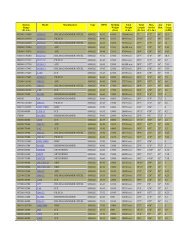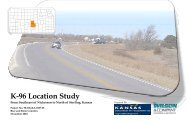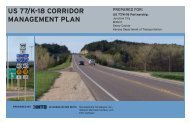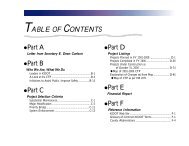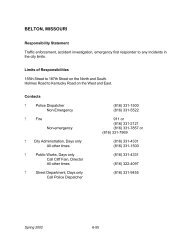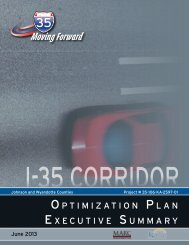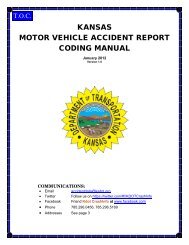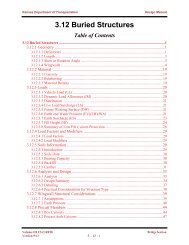Full Plan - Kansas Department of Transportation
Full Plan - Kansas Department of Transportation
Full Plan - Kansas Department of Transportation
Create successful ePaper yourself
Turn your PDF publications into a flip-book with our unique Google optimized e-Paper software.
eceiver and a laptop computer to generate the database. The base map may be complete<br />
as early as September 1999, with a final report by year’s end.<br />
Because many rural ITS applications are dependent on some form <strong>of</strong> wireless<br />
communications, implementers <strong>of</strong>ten turn to cellular telecommunications for transmitting<br />
information. However, the available sources <strong>of</strong> information related to cellular coverage<br />
are limited. Most <strong>of</strong>ten, coverage maps originate with the cellular service provider, who<br />
has a vested interest in showing the coverage to be as complete as possible, sometimes to<br />
the point <strong>of</strong> providing unreliable information.<br />
The magnitude <strong>of</strong> the benefits <strong>of</strong> any system that relies on cellular communications<br />
depends heavily on the extent <strong>of</strong> the cellular coverage. Without an accurate picture <strong>of</strong><br />
this coverage, decisions about investments in rural ITS technologies become much more<br />
difficult and risky. Adequate information allows resources to be used more effectively.<br />
1.1.9 GIS Study<br />
The KDOT Cartography Unit <strong>of</strong> the Bureau <strong>of</strong> <strong>Transportation</strong> <strong>Plan</strong>ning is in the process<br />
<strong>of</strong> completing a study to determine all <strong>of</strong> the potential GIS related projects in KDOT.<br />
The study found 27 potential GIS applications for KDOT. The study will also rank these<br />
projects in order <strong>of</strong> priority. The study is due to be completed by August 1999.<br />
Of the 27 projects that were identified, four <strong>of</strong> them were requested by the ITS Unit <strong>of</strong><br />
the Bureau <strong>of</strong> <strong>Transportation</strong> <strong>Plan</strong>ning. Two <strong>of</strong> these projects involve using a GIS<br />
interface for tracking and controlling ITS field elements in both the <strong>Kansas</strong> City TOC and<br />
the Wichita TOC. Another <strong>of</strong> these projects involves using a GIS database to display a<br />
graphical representation <strong>of</strong> cellular coverage throughout <strong>Kansas</strong>. The fourth project<br />
would provide a GIS database and graphical representation <strong>of</strong> the telecommunications<br />
infrastructure that KDOT owns, lease or has rights to.<br />
Three other GIS projects that were requested by the Bureau <strong>of</strong> Construction and<br />
Maintenance also have ITS implications. One <strong>of</strong> these involves developing a web<br />
enabled GIS application for Construction and Detour information. This application<br />
would give field <strong>of</strong>fices the ability to report construction and detour information via the<br />
KDOT intranet and this information could be used to update the Road Condition<br />
Reporting System (RCRS, see section 1.1.15) and the 1-800 travel advisory hot-line (see<br />
1.1.14). The other two projects with ITS implications are automated scheduling and<br />
routing <strong>of</strong> snow plowing activities which would tie into Road Weather Information<br />
Systems (see 1.1.15) and a GIS database for entering maintenance activities which would<br />
be modeled after the RCRS.<br />
Baseline Condition Report 1-13<br />
Section 1 <strong>of</strong> the <strong>Kansas</strong> Statewide ITS <strong>Plan</strong><br />
July, 00



